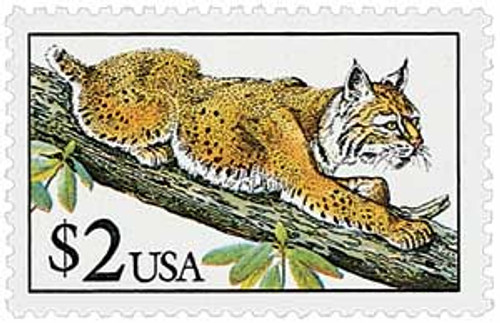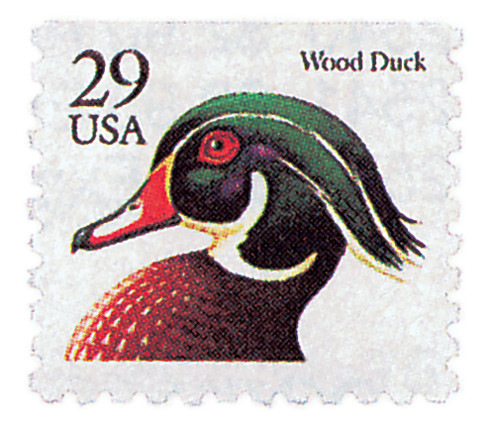
# 3048 FDC - 1996 20c Blue Jay, booklet single
US #3048
1996 Blue Jay
- First Day Cover
- Covered the postcard rate
- Part of Flora and Fauna series
- Same design as 1995 stamp
Category of Stamp: Definitive
Set: Flora and Fauna
Value: 20¢, postcard rate
First Day of Issue: August 2, 1996
First Day City: St. Louis, Missouri
Printed by: J.W. Fergusson & Sons for Stamp Venturers
Printing Method: Photogravure
Format: 1 pane of 10 vertical stamps
Perforations: die cut
Reason the stamp was issued: The stamp was issued to cover the postcard rate. The format was intended for use in vending machines. The 10-stamp booklet was issued with tourists in mind, who sent postcards from their vacation spots and needed fewer stamps than the traditional 20-stamp booklet offered.
About the stamp design: Robert Giusti created the acrylic painting of the blue jay used for the stamp design. His work can be seen on other stamps including the Wild Animals booklet (#2705-09) and the Cardinal (#2480) and Wood Duck (#2484 & #2485), which are also part of the Flora and Fauna Series. Guisti calls his approach to painting “stylized realism.”
Special design details: This version differs from the previous issued not only in the type of gum used but also with a small “1996” under the denomination.
First Day City: The First Day of Issue ceremony for the Blue Jay stamp was held during Americover 96, the annual meeting of the American First Day Cover Society. The event took place in St. Louis, Missouri.
Unusual thing about this stamp: This Blue Jay stamp was the first postcard rate stamp to be produced as a self-adhesive.
About the Flora and Fauna Series:
On June 1, 1990, the USPS issued the first stamp in the Flora and Fauna series. The series began with plans for a Priority Mail stamp in 1987. At the time, the USPS was considering what to feature on their new Priority Mail stamp. Express Mail stamps at the time pictured eagles, so they thought Priority stamps could picture fast land animals.
The USPS then tasked three artists with providing some wildlife artwork for consideration. However, they didn’t act on the artwork and filed it away. The following year, the USPS did use one of the pieces, a pheasant painting by Chuck Ripper, for a stamp needed for the new 25¢ first-class rate.
By 1990, the USPS was ready to replace the Great Americans series, which had begun in 1980. Early in the year, there was an urgent need for $2 stamps, as their stocks of $2 William Jennings Bryan stamps was depleted about six weeks before the new stamp was issued. The USPS chose another of Chuck Ripper’s paintings, of a bobcat, to grace the new $2 stamp.
One thing the USPS knew they wanted to do with the new series was place the higher values on larger sized stamps, to help postal workers more easily distinguish $1, $2, and $5 stamps from 1¢, 2¢, and 5¢ stamps. They considered using the special-issue size used for Christmas and Love stamps but ultimately decided to go with the regular commemorative size “to give the collector and the user of these stamps more for their money” according to one USPS official.
The $2 bobcat stamp that began the new series was issued on June 1, 1990, at the opening of NAPEX 90, the show of the National Philatelic Exhibitions of Washington, DC, held in Arlington, Virginia. The president of NAPEX 90, as well as a naturalist from the National Wildlife Federation, were among those that addressed the crowd. During the ceremony, a postal official said, “This is the first issue planned in the conversion of high-value sheet stamps from the Great Americans series to the colorful, commemorative-size Wildlife series. The $2 Bobcat stamp is a regular issue and will remain in use for a number of years. Eventually, the format of the $1 and $5 regular issues will follow in the tracks of the Bobcat stamp.” The $2 bobcat was issued in a mini-sheet of 20. The selvage including the words “American Wildlife” and “Bobcat (Lynx rufus),” though the animal wasn’t identified by name on the stamp.
In 1991, lower-value definitives were needed, and the USPS made a break with tradition. Going forward, all values less than 10¢ would have a zero before them and no cents sign. However, in 1995, they reversed that decision, and went back to using a cents sign without the leading zero.
For most of the series’ life, it was referred to as the Wildlife Series. Then with the issue of the 2¢ Red-Headed Woodpecker on June 22, 1999, the USPS began calling it the Flora and Fauna Series. Over the course of the series, there were 36 face-different stamps (55 in all) that pictured a wide variety of flora and fauna. The flora included flowers, berries, fruit and a pinecone, while the fauna consisted mostly of birds as well as a fawn, squirrel, honeybee, fox, and sunfish. These stamps were issued in a variety of formats – sheets, booklets, coils – and as perforated with water-activated gum or with straight edges or serpentine die cuts with self-adhesive gum.
The first Distinguished Americans stamps were issued to replace this series in 2000, and the final Flora and Fauna stamps were issued in May 2001.
History the stamp represents: Blue Jays were featured twice before on US postage stamps. They were part of the Capex 78 souvenir sheet (#1757d) and the American Wildlife pane (#2318).
This species is known for its brilliant blue plumage and its loud “jay, jay!” call. It can be found throughout the eastern US and into southern Canada. Blue jays gather in large flocks and are known to harass anything in their territory, including humans.
US #3048
1996 Blue Jay
- First Day Cover
- Covered the postcard rate
- Part of Flora and Fauna series
- Same design as 1995 stamp
Category of Stamp: Definitive
Set: Flora and Fauna
Value: 20¢, postcard rate
First Day of Issue: August 2, 1996
First Day City: St. Louis, Missouri
Printed by: J.W. Fergusson & Sons for Stamp Venturers
Printing Method: Photogravure
Format: 1 pane of 10 vertical stamps
Perforations: die cut
Reason the stamp was issued: The stamp was issued to cover the postcard rate. The format was intended for use in vending machines. The 10-stamp booklet was issued with tourists in mind, who sent postcards from their vacation spots and needed fewer stamps than the traditional 20-stamp booklet offered.
About the stamp design: Robert Giusti created the acrylic painting of the blue jay used for the stamp design. His work can be seen on other stamps including the Wild Animals booklet (#2705-09) and the Cardinal (#2480) and Wood Duck (#2484 & #2485), which are also part of the Flora and Fauna Series. Guisti calls his approach to painting “stylized realism.”
Special design details: This version differs from the previous issued not only in the type of gum used but also with a small “1996” under the denomination.
First Day City: The First Day of Issue ceremony for the Blue Jay stamp was held during Americover 96, the annual meeting of the American First Day Cover Society. The event took place in St. Louis, Missouri.
Unusual thing about this stamp: This Blue Jay stamp was the first postcard rate stamp to be produced as a self-adhesive.
About the Flora and Fauna Series:
On June 1, 1990, the USPS issued the first stamp in the Flora and Fauna series. The series began with plans for a Priority Mail stamp in 1987. At the time, the USPS was considering what to feature on their new Priority Mail stamp. Express Mail stamps at the time pictured eagles, so they thought Priority stamps could picture fast land animals.
The USPS then tasked three artists with providing some wildlife artwork for consideration. However, they didn’t act on the artwork and filed it away. The following year, the USPS did use one of the pieces, a pheasant painting by Chuck Ripper, for a stamp needed for the new 25¢ first-class rate.
By 1990, the USPS was ready to replace the Great Americans series, which had begun in 1980. Early in the year, there was an urgent need for $2 stamps, as their stocks of $2 William Jennings Bryan stamps was depleted about six weeks before the new stamp was issued. The USPS chose another of Chuck Ripper’s paintings, of a bobcat, to grace the new $2 stamp.
One thing the USPS knew they wanted to do with the new series was place the higher values on larger sized stamps, to help postal workers more easily distinguish $1, $2, and $5 stamps from 1¢, 2¢, and 5¢ stamps. They considered using the special-issue size used for Christmas and Love stamps but ultimately decided to go with the regular commemorative size “to give the collector and the user of these stamps more for their money” according to one USPS official.
The $2 bobcat stamp that began the new series was issued on June 1, 1990, at the opening of NAPEX 90, the show of the National Philatelic Exhibitions of Washington, DC, held in Arlington, Virginia. The president of NAPEX 90, as well as a naturalist from the National Wildlife Federation, were among those that addressed the crowd. During the ceremony, a postal official said, “This is the first issue planned in the conversion of high-value sheet stamps from the Great Americans series to the colorful, commemorative-size Wildlife series. The $2 Bobcat stamp is a regular issue and will remain in use for a number of years. Eventually, the format of the $1 and $5 regular issues will follow in the tracks of the Bobcat stamp.” The $2 bobcat was issued in a mini-sheet of 20. The selvage including the words “American Wildlife” and “Bobcat (Lynx rufus),” though the animal wasn’t identified by name on the stamp.
In 1991, lower-value definitives were needed, and the USPS made a break with tradition. Going forward, all values less than 10¢ would have a zero before them and no cents sign. However, in 1995, they reversed that decision, and went back to using a cents sign without the leading zero.
For most of the series’ life, it was referred to as the Wildlife Series. Then with the issue of the 2¢ Red-Headed Woodpecker on June 22, 1999, the USPS began calling it the Flora and Fauna Series. Over the course of the series, there were 36 face-different stamps (55 in all) that pictured a wide variety of flora and fauna. The flora included flowers, berries, fruit and a pinecone, while the fauna consisted mostly of birds as well as a fawn, squirrel, honeybee, fox, and sunfish. These stamps were issued in a variety of formats – sheets, booklets, coils – and as perforated with water-activated gum or with straight edges or serpentine die cuts with self-adhesive gum.
The first Distinguished Americans stamps were issued to replace this series in 2000, and the final Flora and Fauna stamps were issued in May 2001.
History the stamp represents: Blue Jays were featured twice before on US postage stamps. They were part of the Capex 78 souvenir sheet (#1757d) and the American Wildlife pane (#2318).
This species is known for its brilliant blue plumage and its loud “jay, jay!” call. It can be found throughout the eastern US and into southern Canada. Blue jays gather in large flocks and are known to harass anything in their territory, including humans.
















